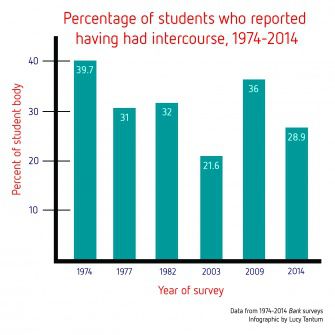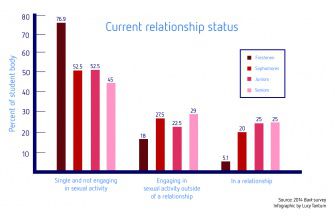When Miley Cyrus “twerked” at the Video Music Awards this fall, she instigated a public discussion about the increasingly sexual nature of content in the media. But the effects of such a trend are not evident in the sexual behavior of Redwood students.
Fewer Redwood students today are having sex than their counterparts 40 years ago, according to the January Bark survey.
In 1974, 39.7 percent of students reported having intercourse. This year’s survey indicated that just 28.9 percent of students have had sex. The statistic has, however, increased in the past ten years, as the 2003 survey indicated that only 21 percent of students had participated in intercourse.

As expected, students reported more sex in later grades. Only 2.5 percent of freshmen and 20.0 percent of sophomores reported having intercourse, numbers which jumped to 37.5 percent of juniors and 55.0 percent of seniors. The percentage of seniors has barely shifted since 1974, when 56 percent of senior boys and 50 percent of senior girls reported having engaged in intercourse.
About a fifth, 19.6 percent, of students who have had sex lost their virginity while under the influence of drugs or alcohol.
Of students who have not had intercourse, fewer have engaged in oral sex today than 40 years ago. In 1974, 30 percent of those who had not participated in intercourse had participated in oral sex, compared to just 12.4 percent this year.
Not only are students engaging in less intercourse, but they are also practicing safer sex. In 1974, only 51.8 percent of sexually active students used contraceptives. Today, 89.1 percent of students who have engaged in intercourse said either they or their partner usually wear a condom.
In addition to increasing measures to prevent pregnancies, students’ views on what should happen once a girl is pregnant have also shifted dramatically. This year, 61.6 percent of students said abortion should always be permitted, compared to 50 percent of students in 1977 when the question was first asked.
Today, more girls, 59.5 percent, than boys, 48.8 percent, said they would most likely abort the baby if they or their partner became pregnant.
In regards to abortion, students had a variety of reactions as to what they would do if they or their partner became pregnant. According to the survey, 17.5 percent of the student body said they would have and keep the child, and 11.3 percent said they would want to give the child up for adoption. Nearly half, 48.8 percent said they would have an abortion while 22.8 percent said they would choose other.
Views on abortion also varied based on sexual experience. Of both male and female students who reported having intercourse, 78.3 percent said they would likely abort the child in the case of a pregnancy. Just 44.2 percent of Redwood virgins said they would probably choose abortion.
Of boys who reported no sexual activity, 35.3 percent said they never masturbate, compared to just 9.5 percent of boys who reported sexual activity. The survey indicated that 32.5 percent of Redwood boys masturbate on a weekly basis, and 21.3 percent do so on a daily basis.

In an era in which same-sex marriage has become a hot topic, Redwood students exhibit a far more accepting perspective on homosexuality compared to 40 years ago. Only 3.1 percent of students said they thought homosexuality was an illness, compared to 37 percent in 1974, 22 percent in 1977, 21 percent in 1982, and 20 percent in 1985, and 9 percent in 2003.
The data also suggests that sex is tied to relationships. Of students who have had sex, 41.3 percent are currently in a relationship, compared to just 9.7 percent of students who have not had intercourse. Similarly, 84.8 percent of students who have had intercourse have said “I love you” to a significant other, far more than the 38.9 percent of students who have not had intercourse.
A new development that could not have been foreseen when the survey was first implemented in 1974 is the advent of “sexting,” or the digital sending of images with sexually explicit content. One-third of survey-takers reported that they had sent such images. Exactly half of students who reported having sex said they had sent sexually explicit images, while just 26.5 percent of virgins said they had.
Students who have engaged in intercourse are also more likely to both take part in “slut-shaming” and be the target of “slut-shaming,” according to the recent survey data. Of students who said they have had sex, 43.5 percent said they have been made to feel inferior for their sexual behavior and 39.1 percent said they have publicly done the same to others. Just 23.9 percent of students who have not had sex have been “slut-shamed” and only 22.1 percent have “slut-shamed.”






